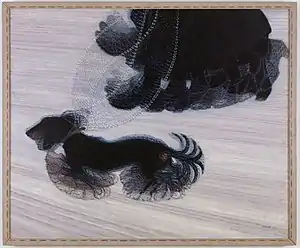Ivan Puni
Ivan Albertovich Puni[1] (Russian: Иван Альбертович Пуни; also known as Jean Pougny; 20 February 1892 – 28 December 1956)[2][3][4] was a Russian avant-garde artist (Suprematist, Cubo-Futurist).
Ivan Puni | |
|---|---|
.jpg.webp) | |
| Born | Ivan Albertovich Puni 20 February 1892 |
| Died | 28 December 1956 (aged 64) Paris, France |
.jpg.webp)
Biography
Early life
Ivan Puni was born in Kuokkala (then Grand Duchy of Finland in the Russian Empire, now Repino in Russia) to a family of Italian origins.[5] He was the grandson of an eminent Italian composer of ballet music, Cesare Pugni. His father, a cellist, insisted that he follow a military career, but Ivan instead decided to take private drawing lessons with Ilya Repin. By 1909, he had his own studio.[1]
Career
Puni continued his formal training in Paris in 1910–11 at the Académie Julien and other schools, where he painted in a derivative fauviste style. Upon his return to Russia in 1912, he married fellow artist Kseniya Boguslavskaya, and met, and exhibited with, members of the St Petersburg avant-garde, including Kazimir Malevich and Vladimir Tatlin.[1] He made a second trip to Paris in 1914, returning to St. Petersburg in 1915. At this point, he began painting in a Cubist style reminiscent of Juan Gris. In 1915, Puni, (Aleksandra Ekster, Liubov Popova, Ivan Kliun, Ksenia Boguslavskaya, Olga Rozanova, Nadezhda Udaltsova, Nina Genke and others) formed Supremus, a group of artists dedicated to the promulgation of Suprematism, the abstract art movement founded by Malevich, and first exhibited at the 0,10 Exhibition. Malevich and Puni co-authored the Suprematist Manifesto, published in 1916, which proclaimed a new, abstract art for a new historical era.
Puni also organized the exhibitions Tramway 5 and 0.10, both held in St Petersburg in 1915, in which Malevich, Tatlin, Popova and others participated, and to which Puni contributed constructions, readymades, and paintings.[1] In 1915-1916 Puni, together with other Suprematist artists, worked at Verbovka Village Folk Centre. In 1919, he taught at the Vitebsk Art School under Marc Chagall.[1]
Years of Exile
Puni and his wife, Kseniya Boguslavskaya, emigrated from Russia in 1919, first to Finland, then in 1920 to Berlin,[1] where the first exhibition consisting entirely of his work was held at the Galerie der Sturm. While in Berlin, Puni also designed costumes and sets for theatrical productions, and published a book criticising Suprematism.[1]
Puni and Boguslavskaya relocated to Paris in 1924,[1] where his style changed once again to a variant of Impressionism. In France, he signed his work as "Jean Pougny", in an effort to distance his new art practice from his previous one in Russia. In 1946, Puni/Pougny became a French citizen. He died in Paris in 1956.
See also
References
- Sarabianov, Andrei D. "Ivan Albertovich Puni". Encyclopedia Brittanica. Retrieved 6 June 2020.
- ru: Русская живопись // Пуни Иван Альбертович (1892—1956)
- ru: Пуни Иван Альбертович (1892—1956)
- ru: ПУНИ Иван (Жан) Альбертович / Pougny Jean
- "Kuokkala". Archived from the original on October 26, 2009. Retrieved 2006-12-11.CS1 maint: bot: original URL status unknown (link)
External links
- pougny-jean-ivan-puni-called Ivan Puni in American public collections, on the French Sculpture Census website


